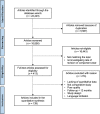Head, acetabular liner composition, and rate of revision and wear in total hip arthroplasty: a Bayesian network meta-analysis
- PMID: 37989863
- PMCID: PMC10663607
- DOI: 10.1038/s41598-023-47670-z
Head, acetabular liner composition, and rate of revision and wear in total hip arthroplasty: a Bayesian network meta-analysis
Abstract
Total hip arthroplasty (THA) is a common procedure for patients suffering from hip pain e.g. from osteoarthritis, osteonecrosis, or hip fractures. The satisfaction of patients undergoing THA is influenced by the choice of implant type and material, with one key factor being the selection of the appropriate material combination for the bearing surface. In this Bayesian network meta-analysis, we investigated the impact of material combinations for the bearing surface on the longevity of hip implants. The wear penetration rate per year and the total wear penetration in the liner resulting from different material combinations, as well as the survival rate at last follow-up, were examined. We analyzed a total of 663,038 THAs, with 55% of patients being women. Mean patient age was 59.0 ± 8.1 years and mean BMI 27.6 ± 2.6 kg/m2. The combination of an aluminium oxide (Al2O3) head and an Al2O3 liner demonstrated the lowest wear penetration at last follow-up and the lowest rate of wear penetration per year. Additionally, the combination of a crosslinked polyethylene (XLPE) liner and a zircon oxide (ZrO2) head demonstrated the lowest rate of revision at last follow-up. These findings underscore the importance of careful material selection for hip implant bearing surfaces to optimize their longevity and patient satisfaction after THA.
© 2023. The Author(s).
Conflict of interest statement
The authors declare no competing interests.
Figures





Similar articles
-
Oxidized zirconium head on crosslinked polyethylene liner in total hip arthroplasty: a 7- to 12-year in vivo comparative wear study.Clin Orthop Relat Res. 2015 Dec;473(12):3836-45. doi: 10.1007/s11999-015-4503-7. Clin Orthop Relat Res. 2015. PMID: 26290343 Free PMC article. Clinical Trial.
-
Rate of revision and wear penetration in different polyethylene liner compositions in total hip arthroplasty: a Bayesian network meta-analysis.Sci Rep. 2024 Sep 10;14(1):21162. doi: 10.1038/s41598-024-71326-1. Sci Rep. 2024. PMID: 39256531 Free PMC article.
-
Otto Aufranc Award: Crosslinking Reduces THA Wear, Osteolysis, and Revision Rates at 15-year Followup Compared With Noncrosslinked Polyethylene.Clin Orthop Relat Res. 2018 Feb;476(2):279-290. doi: 10.1007/s11999.0000000000000036. Clin Orthop Relat Res. 2018. PMID: 29529656 Free PMC article. Clinical Trial.
-
Risk factors for liner wear and head migration in total hip arthroplasty: a systematic review.Sci Rep. 2023 Sep 20;13(1):15612. doi: 10.1038/s41598-023-42809-4. Sci Rep. 2023. PMID: 37730762 Free PMC article.
-
Wear of highly crosslinked polyethylene acetabular components.Acta Orthop. 2015 Apr;86(2):159-68. doi: 10.3109/17453674.2014.972890. Epub 2014 Oct 10. Acta Orthop. 2015. PMID: 25301435 Free PMC article. Review.
Cited by
-
Relating total hip replacement and acetabular cup positioning with outcome: A systematic review.Bioinformation. 2025 Feb 28;21(2):145-154. doi: 10.6026/973206300210145. eCollection 2025. Bioinformation. 2025. PMID: 40322696 Free PMC article.
-
Progression of cortical hypertrophy, subsidence and thigh pain after short curved fitmore femoral hip stem over 10 years.J Orthop Surg Res. 2025 Jul 14;20(1):649. doi: 10.1186/s13018-025-06064-9. J Orthop Surg Res. 2025. PMID: 40660277 Free PMC article.
-
Arthroscopic assisted versus open core decompression for osteonecrosis of the femoral head: A systematic review and meta-analysis.PLoS One. 2024 Nov 15;19(11):e0313265. doi: 10.1371/journal.pone.0313265. eCollection 2024. PLoS One. 2024. PMID: 39546449 Free PMC article.
-
The addition of vitamin E could reduce femoral head penetration of the polyethylene liners.J Orthop Surg Res. 2025 Jan 20;20(1):72. doi: 10.1186/s13018-024-05402-7. J Orthop Surg Res. 2025. PMID: 39833940 Free PMC article.
-
Proof of Concept of a New Revision Procedure for Ceramic Inlays of Acetabular Cups Using a Shape-Memory Alloy Actuator System.Bioengineering (Basel). 2024 Aug 27;11(9):868. doi: 10.3390/bioengineering11090868. Bioengineering (Basel). 2024. PMID: 39329611 Free PMC article.
References
-
- Howick, J. C. I., Glasziou, P., Greenhalgh, T., Heneghan, C., Liberati, A., Moschetti, I., Phillips, B., Thornton, H., Goddard, O. & Hodgkinson, M. The 2011 Oxford CEBM Levels of Evidence. Oxford Centre for Evidence-Based Medicine (2011). Available at https://www.cebmnet/indexaspx?o=5653 .
-
- Evans JT, Evans JP, Walker RW, Blom AW, Whitehouse MR, Sayers A. How long does a hip replacement last? A systematic review and meta-analysis of case series and national registry reports with more than 15 years of follow-up. Lancet. 2019;393:647–654. doi: 10.1016/S0140-6736(18)31665-9. - DOI - PMC - PubMed
Publication types
MeSH terms
Substances
LinkOut - more resources
Full Text Sources
Medical

